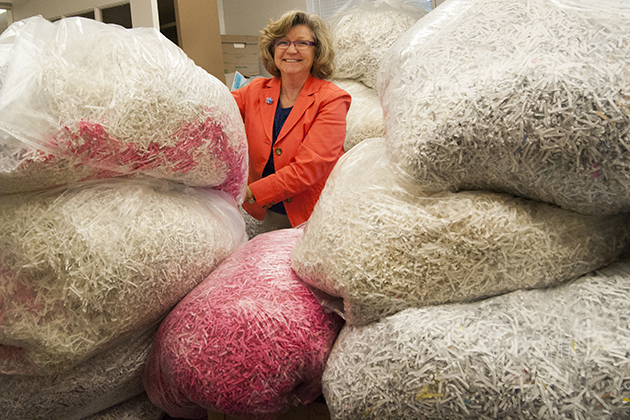
Huge bags filled with white and hot pink shreds of paper – the remains of student evaluations past – practically fill one room at the Budds Building, stacked from floor to ceiling.
“This is nothing,” says Cheryl Williams, who oversees student evaluations for the Office of Institutional Research. “You should see it when it’s really bad.”
Soon, though, those giant bags will be a thing of the past, as UConn launches this month a brand-new format for Student Evaluations of Teaching, or SET, that will be completed online for the first time.
The change will benefit the University in two ways, explains Suresh Nair, interim associate vice provost for institutional effectiveness. First, as part of UConn’s commitment to environmental responsibility, the new evaluation will eliminate the reams of paper used for bubble sheets and comment sheets in the past, along with the associated printing and scanning. Secondly, the redesigned evaluation will provide the University with better information from students about their courses.
“The research has shown that comments about courses are more extensive in online surveys than written evaluations,” he says. “This is something most of our peer institutions are already doing, and the research shows that there’s no significant difference in how students rate their professors online versus on paper.”
A new website with information on the new survey, including an FAQ for students, has been launched at: http://www.oir.uconn.edu/onlineset/onlineset.html. Instructors will be able to access the new evaluation forms from April 15 to April 20, and can add up to three questions. Students will then have access from April 22 to May 3.
Most of the basics will remain the same: survey responses will be anonymous, and only instructors will be able to read comments. But the evaluations will now be more comprehensive, with one section devoted to questions about the instructor, and a separate section devoted to questions about the course itself.
The new online format means the results will be ready much sooner than with paper evaluations, which used to take Williams’ office a month or longer to fully process.
“This is going to help instructors incorporate the comments into their planning much quicker than in the past,” Nair says.
Although the surveys can be completed online at any time, the University is strongly encouraging instructors to set aside 15 minutes of class time for students to complete the evaluations using their laptops, tablets, or smart phones. Response rates are higher when instructors devote time in class to getting the information, Nair says.
And while some institutions withhold grades until students complete evaluations, the UConn SETs remain voluntary, although Williams says it is crucial that students complete them, since the evaluations are used in decisions ranging from tenure to academic planning.
“We’ll be sending out reminder emails to students,” she says. “We really encourage them to have their voices heard, because their feedback is so crucial to course development and planning, and the University really counts on it.”



